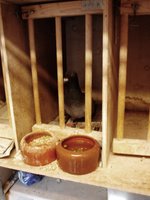Out in the Field

Last week, I finally had the opportunity to see a racing pigeon RFID system in action. I visited Henk van Linden in Utrecht, about an hour from Rotterdam. As Henk only spoke dutch, I was lucky to have Hein, my project manager, with me to help me out.
Henk comes from a family of pigeon aficionados, his father introduced him to this intensive pasttime. Despite living in a tightly housed district, the pigeon cage, which is based in the backyard, covers a good half of the back yard and is two storeys high, the upper part which contains the landing platforms accessible by a small ladder.
The roughly 30 birds he owns are mostly his own breed plus a few bought ones to keep his own pigeon's DNA set active.


He normally spends about 2 hours each day for them to feed and let them fly. At the time of our visit, he had one that had an inflamed digestive system and therefore needed some extra care and time. During the racing season he spends a good 4 hrs a day with the pigeons and getting up as early as six in the morning for the first feeding, seemingly keeping a man of a 60+ age active and healthy. For the training, apart from a sophisticated feeding plan, he lets them fly once a day and some are then gone, especially the females for a good two hours.

 When they return they then each trigger the reader's antenna which is located withing the landing platform, through their individual tags, in the small plastic rings attached to their feet(see "The Germans Are Coming" below for photo). He can check the readings with a small handheld controller that displays each tag when being read. We tested a few blanks and one of my own tags I had brought with me. As much as my tag contains a chip with an ID , there is no further information attached to it of course. The way it works is that he brings his pigeons to the clubhouse and they put the tag on the pigeon there, where the pigeon's information is then entered into a centralised database for future races and analysis.
When they return they then each trigger the reader's antenna which is located withing the landing platform, through their individual tags, in the small plastic rings attached to their feet(see "The Germans Are Coming" below for photo). He can check the readings with a small handheld controller that displays each tag when being read. We tested a few blanks and one of my own tags I had brought with me. As much as my tag contains a chip with an ID , there is no further information attached to it of course. The way it works is that he brings his pigeons to the clubhouse and they put the tag on the pigeon there, where the pigeon's information is then entered into a centralised database for future races and analysis.Surprised that a hobbyist can afford such a system, he confirmed that apart from one member, the whole club is using it, he said it was an investment, but the additional data he and others are getting with the system is impressive, plus it makes lost pigeons be found easier, especially as it is not uncommon that pigeons fly with another flock and end up in other people's cages.

What I was still mosty impressed was not the technology, which works all fine and well, but the fact that this man spends so much time studying and monitoring these animals. His link with these animals is obviously a strong one and based on this he confirmed that when he walks through the city his perception of any bird in sight is a much different one than anyone else not involved in bird sport.
As odd as pigeon racing might seem to some(yet it is a worldwide phenomenon in a multi billion dollar range due to betting on races) the effect this fascination of animals has on an individual is impressive, and I can presume that Henk van Linden has found something others are looking for their whole life to keep them active and happy.

0 Comments:
Post a Comment
<< Home